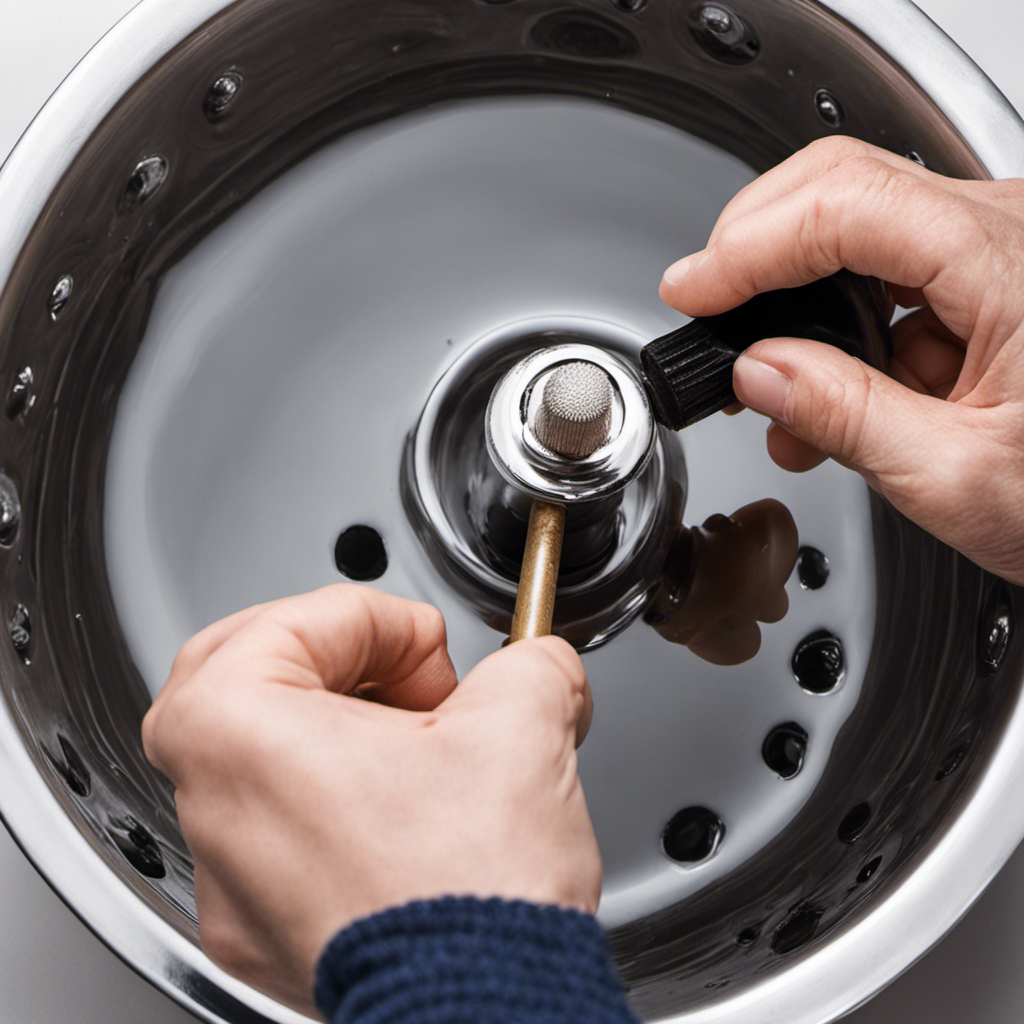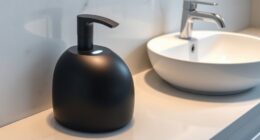Hey there, folks! Ever found yourself ankle-deep in water while taking a relaxing bath? Well, fear not! I’m here to help you unclog that stubborn bathtub drain.
In this step-by-step guide, we’ll tackle everything from assessing the severity of the clog to utilizing natural remedies and even chemical drain cleaners as a last resort.
So, grab your plunger and let’s get to work!
Key Takeaways
- Assess the severity of the clog by observing drainage speed and listening for gurgling sounds
- Gather necessary tools and materials such as a plunger, rubber gloves, bucket, and towels
- Use methods like plunging or using a drain snake to remove excess debris from the drain
- Consider using chemical drain cleaners as an alternative, but follow safety precautions and rinse the drain thoroughly afterwards.
Assess the Severity of the Clog
Now, you’ll need to determine how bad the clog is. Assessing the severity of the clog is crucial in order to choose the appropriate method for unclogging your bathtub drain.
There are a few common causes that can lead to a clogged drain, such as hair buildup, soap scum, or foreign objects.
To assess the severity, start by observing how quickly the water is draining. If it’s slow but still draining, the clog may be minor. However, if the water isn’t draining at all or is backing up, the clog is likely more severe. Another sign of a severe clog is if you hear gurgling sounds when water is draining.
Understanding the severity will help you determine the best course of action to unclog your bathtub drain.
Gather the Necessary Tools and Materials
First, you’ll need to gather all the tools and materials necessary for the job. Here’s a step-by-step guide on what you’ll need:
-
Plunger: A plunger is an essential tool for unclogging a bathtub drain. Make sure it’s the right size for your drain.
-
Rubber gloves: It’s important to protect your hands from any debris or chemicals that may come into contact during the unclogging process.
-
Bucket: Having a bucket nearby will allow you to collect any water or debris that comes out of the drain.
-
Towels: Keep a few towels handy to wipe up any spills or messes that may occur during the unclogging process.
Now that you have all the necessary tools and materials, you’re ready to move on to the next step: assessing the severity of the clog.
Remove Excess Debris From the Drain
When it comes to unclogging a drain, there are a few different methods to consider.
Two common options are using a plunger or a drain snake. A plunger works by creating suction and pressure to dislodge the clog, while a drain snake physically breaks up the obstruction.
Another option is to use chemical drain cleaners, which chemically dissolve the clog.
Each method has its pros and cons, so it’s important to understand them before choosing the best approach for your specific situation.
Plunger Vs. Drain Snake
To unclog your bathtub drain, there are two main tools you can use: a plunger or a drain snake. Both tools have their own pros and cons, so it’s important to know what to expect from each.
-
Plungers are easy to use and can be found in most households. They create suction that can dislodge clogs in the drain. However, they may not be effective for severe or stubborn clogs. Using a plunger also requires a certain level of skill and technique to use properly.
-
Drain snakes, also known as augers, are specifically designed for clearing clogs in pipes. They are more powerful than plungers and can reach deeper into the drain. Some drain snakes even come with interchangeable heads for different types of clogs. However, drain snakes can be more expensive than plungers and may require some practice to use effectively. If used incorrectly or with excessive force, drain snakes can potentially damage the pipes.
Chemical Drain Cleaners
Chemical drain cleaners are an alternative option for clearing clogs in your pipes. However, it is important to take safety precautions when using them. These cleaners contain strong chemicals that can be harmful if mishandled. Here are some safety tips to follow:
-
Always wear protective gloves and goggles to shield yourself from potential splashes or fumes.
-
Read and follow the instructions carefully. Different cleaners have different application methods and contact times.
-
Keep the area well-ventilated to minimize inhalation of fumes.
-
Never mix different drain cleaners together, as this can cause dangerous chemical reactions.
-
After using the cleaner, thoroughly rinse the drain with water to remove any remaining chemicals.
Alternatively, if you prefer to avoid chemical drain cleaners, there are other methods to unclog a bathtub drain. Here are some alternatives:
-
Use a plunger to create suction and dislodge the clog.
-
Use a drain snake or auger to physically remove the blockage.
-
Try natural remedies such as baking soda and vinegar, or a combination of hot water and dish soap.
Use a Plunger to Attempt to Clear the Clog
First, grab a plunger and position it over the drain to try and clear the clog. This is one of the most common and effective methods to unclog a bathtub drain. Here are some plunger techniques and troubleshooting tips to help you tackle the clog:
-
Create a tight seal: Ensure that the plunger completely covers the drain opening to create a vacuum seal. This will maximize the pressure and suction needed to dislodge the clog.
-
Push and pull: Use quick, forceful plunging motions to push and pull the plunger in and out of the drain. This action helps to break up the clog and move it along.
-
Be persistent: Don’t give up after a few attempts. Sometimes, it takes several rounds of plunging to fully clear the clog.
-
Use hot water: After plunging, run hot water down the drain to help flush out any remaining debris.
Try Using a Drain Snake or Auger
After attempting to clear the clog with a plunger, you may want to consider using a drain snake or auger. A drain snake is a flexible tool used to break up and remove clogs in pipes.
To use a drain snake, follow these steps:
- Insert the end of the snake into the drain opening.
- Rotate the handle clockwise to push the snake further into the pipe.
- Continue pushing and rotating the snake until you feel resistance.
- Once you reach the clog, rotate the snake counterclockwise to break it up.
- Slowly pull the snake out, removing any debris or clog remnants.
Remember to clean and maintain your drain snake after each use to prevent any buildup or damage. If using a drain snake doesn’t work, there are alternative clog removal methods you can try.
Utilize Natural Remedies to Break up the Clog
When it comes to natural remedies for unclogging drains, two key points to consider are vinegar and baking soda, as well as a hot water flush.
First, I would recommend pouring a mixture of vinegar and baking soda down the drain, as this combination creates a chemical reaction that can help break up the clog. After letting it sit for about 15 minutes, follow up with a hot water flush to help wash away any remaining debris.
This method can be effective in clearing minor clogs and is a safe and environmentally friendly alternative to harsh chemical drain cleaners.
Vinegar and Baking Soda
To begin, you’ll need to mix vinegar and baking soda together to create a powerful unclogging solution. Here’s how you can do it step-by-step:
-
Measure out 1 cup of white vinegar and pour it down the drain. Vinegar has many benefits when it comes to unclogging drains. Its acidic nature helps break down the clog and remove any built-up residue.
-
Next, pour 1 cup of baking soda into the drain. Baking soda is known for its uses in various cleaning solutions, and when combined with vinegar, it creates a fizzing reaction that helps dislodge the clog.
-
Let the mixture sit for about 15 minutes. During this time, the vinegar and baking soda will work together to break up the clog.
-
Finally, flush the drain with hot water. This will help wash away any remaining debris and clear the clog completely.
By using vinegar and baking soda, you can effectively unclog your bathtub drain and enjoy the benefits of these natural ingredients.
Now, let’s move on to the next step: the hot water flush.
Hot Water Flush
For the hot water flush, simply let the mixture sit for about 15 minutes before flushing the drain with hot water. This method is one of the simplest and most effective ways to unclog a bathtub drain. The hot water helps to dissolve and flush away any debris or blockages that may be causing the clog.
Here is a step-by-step guide on how to perform a hot water flush:
- Start by boiling a large pot of water.
- Carefully pour the hot water down the drain.
- Let the hot water sit in the drain for about 15 minutes.
- After 15 minutes, turn on the hot water tap and let it run for a few minutes.
- This will help to flush out any remaining debris or blockages.
Consider Using Chemical Drain Cleaners as a Last Resort
If you’re in a bind, you can try using chemical drain cleaners as a last resort to unclog your bathtub drain. However, it’s important to consider the pros and cons of using these products.
Here are some things to keep in mind:
-
Pros of chemical drain cleaners:
- They are easily accessible and can be found at most hardware stores.
- They are relatively inexpensive compared to calling a professional plumber.
- They can effectively dissolve hair, grease, and other clogs.
-
Cons of chemical drain cleaners:
- They contain harsh chemicals that can be harmful to your health and the environment.
- They may not work on severe clogs or blockages.
- They can damage older plumbing pipes or fixtures.
Before resorting to chemical drain cleaners, it’s worth trying alternative methods for unclogging a bathtub drain. These include using a plunger, a drain snake, or a mixture of baking soda and vinegar. These methods are often safer, more environmentally friendly, and have a lower risk of damaging your plumbing.
Prevent Future Clogs With Regular Maintenance and Care
Regular maintenance and care can help prevent future clogs in your plumbing system. To ensure the smooth flow of water through your bathtub drain, there are a few simple steps you can follow.
First, regularly remove any visible debris, such as hair or soap scum, from the drain cover using a pair of tweezers or gloves.
Next, flush the drain with hot water to help remove any buildup.
It’s also important to avoid pouring grease or oil down the drain, as they can solidify and create blockages.
Additionally, using a drain strainer can catch larger particles before they enter the drain.
Finally, consider using a natural drain cleaner, such as a mixture of baking soda and vinegar, to keep your drains clean and odor-free.
Frequently Asked Questions
Can I Use a Liquid Drain Cleaner to Unclog My Bathtub Drain?
I can use a liquid drain cleaner to unclog my bathtub drain, but there are pros and cons. It’s effective but can damage pipes. Alternatively, I can try using a plunger or a drain snake.
How Often Should I Perform Regular Maintenance on My Bathtub Drain to Prevent Clogs?
Regular maintenance is essential to prevent clogs in bathtub drains. By keeping an eye out for signs of a clogged drain, such as slow drainage or standing water, and performing maintenance regularly, you can avoid costly and inconvenient clogs.
Are There Any Natural Remedies That Can Be Harmful to My Bathtub Drain?
Harmful natural remedies should be avoided when trying to unclog a bathtub drain. Instead, opt for eco-friendly alternatives that won’t cause damage. It’s important to prioritize the health of your drain and the environment.
What Should I Do if Using a Plunger Doesn’t Clear the Clog?
If a plunger doesn’t clear the clog, I would recommend using a snake to break up the blockage. However, if this doesn’t work, it may be necessary to seek professional help.
Is It Possible for a Clog in My Bathtub Drain to Be a Sign of a Larger Plumbing Issue?
Is a clog in my bathtub drain a sign of larger plumbing issues? Yes, it could be. Common causes include tree roots, mineral buildup, or a damaged pipe. It’s important to address the issue promptly to prevent further damage.
Conclusion
So there you have it, folks! We’ve reached the end of our journey on how to unclog a bathtub drain.
By now, you should have a clear understanding of the steps involved in tackling this pesky problem. Remember, it’s important to assess the severity of the clog and gather the necessary tools before diving in.
From removing excess debris to utilizing a plunger, drain snake, or natural remedies, we’ve covered it all. And if all else fails, you can consider using chemical drain cleaners as a last resort.
But let’s not forget, prevention is key! Regular maintenance and care will help keep those drains flowing smoothly.
Happy unclogging!










